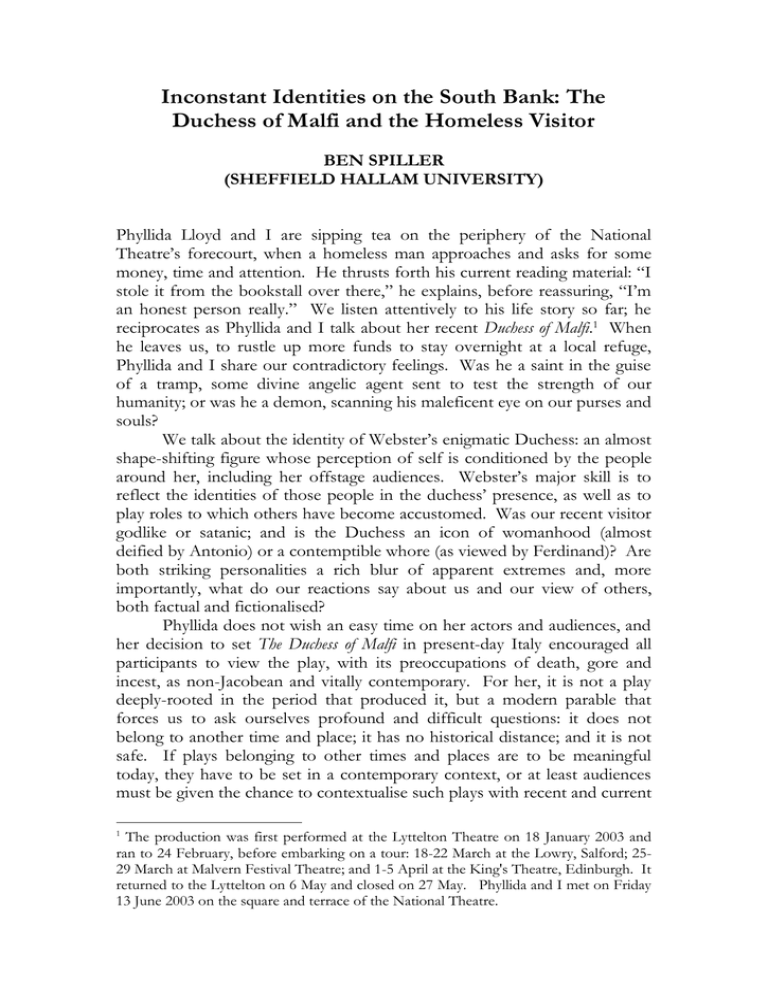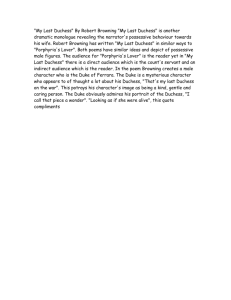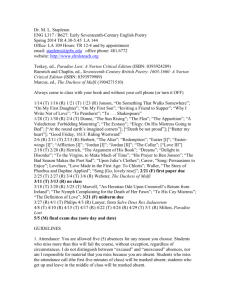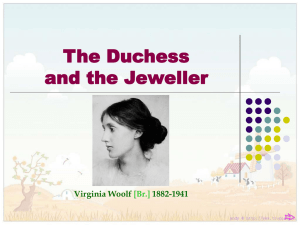Inconstant Identities on the South Bank: The
advertisement

Inconstant Identities on the South Bank: The Duchess of Malfi and the Homeless Visitor BEN SPILLER (SHEFFIELD HALLAM UNIVERSITY) Phyllida Lloyd and I are sipping tea on the periphery of the National Theatre’s forecourt, when a homeless man approaches and asks for some money, time and attention. He thrusts forth his current reading material: “I stole it from the bookstall over there,” he explains, before reassuring, “I’m an honest person really.” We listen attentively to his life story so far; he reciprocates as Phyllida and I talk about her recent Duchess of Malfi.1 When he leaves us, to rustle up more funds to stay overnight at a local refuge, Phyllida and I share our contradictory feelings. Was he a saint in the guise of a tramp, some divine angelic agent sent to test the strength of our humanity; or was he a demon, scanning his maleficent eye on our purses and souls? We talk about the identity of Webster’s enigmatic Duchess: an almost shape-shifting figure whose perception of self is conditioned by the people around her, including her offstage audiences. Webster’s major skill is to reflect the identities of those people in the duchess’ presence, as well as to play roles to which others have become accustomed. Was our recent visitor godlike or satanic; and is the Duchess an icon of womanhood (almost deified by Antonio) or a contemptible whore (as viewed by Ferdinand)? Are both striking personalities a rich blur of apparent extremes and, more importantly, what do our reactions say about us and our view of others, both factual and fictionalised? Phyllida does not wish an easy time on her actors and audiences, and her decision to set The Duchess of Malfi in present-day Italy encouraged all participants to view the play, with its preoccupations of death, gore and incest, as non-Jacobean and vitally contemporary. For her, it is not a play deeply-rooted in the period that produced it, but a modern parable that forces us to ask ourselves profound and difficult questions: it does not belong to another time and place; it has no historical distance; and it is not safe. If plays belonging to other times and places are to be meaningful today, they have to be set in a contemporary context, or at least audiences must be given the chance to contextualise such plays with recent and current 1 The production was first performed at the Lyttelton Theatre on 18 January 2003 and ran to 24 February, before embarking on a tour: 18-22 March at the Lowry, Salford; 2529 March at Malvern Festival Theatre; and 1-5 April at the King's Theatre, Edinburgh. It returned to the Lyttelton on 6 May and closed on 27 May. Phyllida and I met on Friday 13 June 2003 on the square and terrace of the National Theatre. events, through allusions drawn by the director. “Context is all in theatre,” Phyllida reminds me. Focus, intensity and claustrophobia are demanded by Webster’s meditation on the transition between life and death, and Phyllida’s decision to stage it without interval, with almost-always omnipresent cast, created an appropriate theatrical context for performers and audiences alike. Treating the script as something of a screenplay in rehearsal, cutting and rearranging with the assistance of Karl Miller (her dramaturg), facilitated a fast and thrilling pace, with the excitement and urgency often provoked by sharp film editing.2 In the rehearsal process, Phyllida and her actors found a solution to a challenge posed by the final scene of the play, when the stage becomes littered with a pile of mutilated corpses: each of Webster’s characters died one line before the end of their final speech, and spoke their closing words after rising from death before joining the souls of others who died before them. All were lit in small pools of light as they sat on a staircase that ran the width of the performance space: isolated and passive, they witnessed the remaining moments of the play. Janet McTeer’s Duchess, who had accepted her death as an almost welcomed release from the hell she was living, sat centre-stage and constantly reminded us of her continuing, post-death influence on the play. Her absence of focused identity and almost constant passivity in life continued in death. The proscenium arch of the theatre, along with the clearly defined distinction between audience and performance spaces, provided something of a cinematic experience. Video footage projected onto a moveable glass screen added to the filmic dimension of the production; however, visible stage lighting prevented the complete illusion of watching a film, and was a constant reminder of the theatricality of the production and the metatheatricality of the play: DUCHESS […] I account this world a tedious theatre, For I do play a part in ’t ’gainst my will. IV.1.84-5 MALATESTE Thou wretched thing of blood, How came Antonio by his death? BOSOLA In a mist: I know not how – Such a mistake as I have often seen In a play. V.5.92-6 2 The cast members were invited to offer their own cuts throughout rehearsals and the run itself. Cutting and rearranging was an ongoing process. Indeed, the almost constant presence of the actors in the performance space encouraged audiences to view the onstage world as a fictional construction. However, despite Mark Thompson’s ‘Brechtian’3 design, there were moments in the performance when the emotional overcame the cerebral. One such moment took place in III.5, when the Duchess and her children are separated: Antonio must flee with them to escape the wrath and danger of the Duchess’ two brothers, both of whom disapprove of their sister’s second marriage. Janet’s Duchess had already established a close bond with her children in an interpolated sequence that immediately preceded III.2. The children played boisterously with their toys and their mother, who was clearly ecstatic by their very presence. Here, the children and offstage audience perceived Janet as mother; later, Will Keen’s psychotic pill-popping Ferdinand would view her as whore (despite her attempt to act sister and friend to him). Charles Edwards’ charming yet passionate Antonio developed his perception of her from employer to lover; Lorcan Cranitch’s discontented Bosola understood her in the only terms he could: as an image-conscious aristocrat and potential murder victim. Janet personified the passivity of Webster’s Duchess as she reflected the personalities who surrounded her. Far from switching roles according to whoever was near her, others around her – including the offstage audience – perceived Janet as motherly, whore-like, loving and aristocratic. The Duchess was something of an artist’s blank canvass, upon which each character displayed an insight into his or her identity. The void at the centre of the Duchess’ characterisation, and her ability to reflect the personalities of others in her presence, was one of the primary attractions that drew Phyllida close to the play, specifically to its heroine.4 Even when Janet proclaimed ‘I am Duchess of Malfi still’,5 after having endured traumatising drug-induced nightmares (replacing the antiquated ‘masque of madness’ of IV.2), she was still defining herself through another’s identity: that of the Duchess’ dead husband. If Phyllida’s recent rediscovery of Antony and Cleopatra, another of the ‘great plays for girls’,6 coincides with the availability of Janet, then another mythical figure of contradiction and changeability (given new life by another Renaissance playwright), will invite multiple interpretations of a single and enigmatic 3 Phyllida employed the term as a way to describe the design of the production when we met. However, she used it with caution, as a shorthand term of convenience: she did not wish to direct the play as if she were Bertolt Brecht himself. 4 Phyllida first experienced the play when she studied it at A-level. She has been fascinated by it ever since for its moments of ‘near-Shakespearean beauty’, particularly the rich characterisation of the Duchess. 5 IV.2.142. All quotations from the play are taken from John Russell Brown’s Revels edition (Manchester: Manchester University Press, 1974). 6 Phyllida’s terminology; she is constantly searching for such plays, as well as those conventionally seen as unperformable or, as someone once described The Duchess of Malfi to her, ‘a director’s graveyard’. personality in a contemporary theatrical context. Just as Phyllida and I will never be able to definitively interpret our homeless visitor’s identity, directors and audiences of Webster’s Duchess and Shakespeare’s Cleopatra, as well as the actors performing the roles, have been and will continue to be provided with a multitude of theatrical possibilities. The Duchess of Malfi, Lyttelton Theatre and on tour, January to May 2003. PRODUCTION TEAM Director: Phyllida Lloyd Designer: Mark Thompson Lighting Designer: Mark Henderson Music: Gary Yershon Director of Movement: Michael Keegan-Dolan Fight Director: Terry King Sound Designer: Simon Baker for Autograph CAST Doctor: Julien Ball Pescara: Martin Chamberlain Bosola: Lorcan Cranitch Julia: Eleanor David Antonio Bologna: Charles Edwards Fourth Officer: Keiran Flynn First Officer: James Howard Ferdinand, Duke of Calabria: Will Keen Madwoman: Eliza Luymley Third Officer: Keith Macpherson Madwoman: Penelope McGhie The Duchess of Malfi: Janet McTeer Cariola: Sally Rogers Delio: Jonathan Slinger The Cardinal: Ray Stevenson Second Officer: Andrew Westfield. Ben Spiller graduated from Warwick University with a BA in Theatre and Performance Studies (2000) and an MA in Culture of the European Renaissance (2001). He is currently working towards a PhD in English and Cultural Studies at Sheffield Hallam University, the working title of which is ‘”Fellows of infinite jest”: Early Modern/(Post-) Modern Fools in Performance’. Amongst other plays, he has directed Macbeth (Warwick Arts Centre Studio, 1999), Pericles (Codpiece Theatre, 2000), and an open-air production of the First Quarto of Hamlet (Warwick University, 2001). Ben also works for Arts Council England and will be teaching a Shakespeare course at Oxford University in the summer of 2003. E-mail: Ben.Spiller@ntlworld.com







